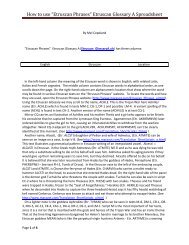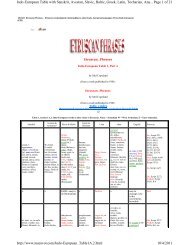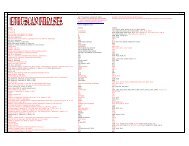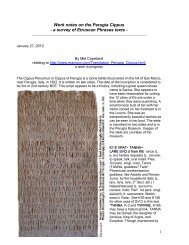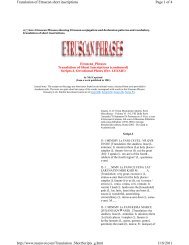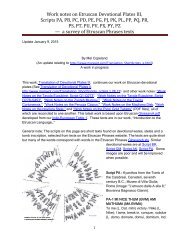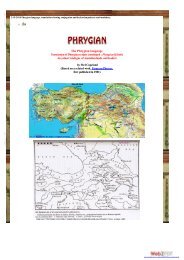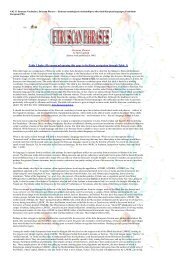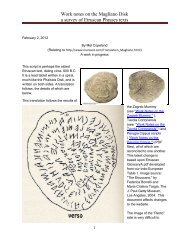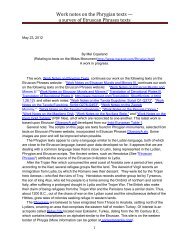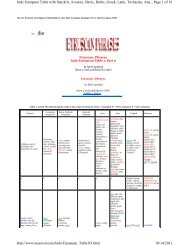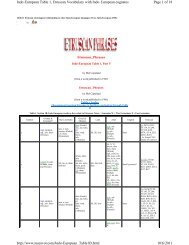Work notes on Etruscan Mirrors and Murals, Part I â - maravot.com
Work notes on Etruscan Mirrors and Murals, Part I â - maravot.com
Work notes on Etruscan Mirrors and Murals, Part I â - maravot.com
- No tags were found...
Create successful ePaper yourself
Turn your PDF publications into a flip-book with our unique Google optimized e-Paper software.
<str<strong>on</strong>g>Work</str<strong>on</strong>g> <str<strong>on</strong>g>notes</str<strong>on</strong>g> <strong>on</strong> <strong>Etruscan</strong> <strong>Mirrors</strong> <strong>and</strong> <strong>Murals</strong>, <strong>Part</strong> I —a survey of <strong>Etruscan</strong> Phrases textsThere are several versi<strong>on</strong>s to thestory of the birth of Helen. Themost popular versi<strong>on</strong> has Zeuschasing the daughter of Night(Gr. Nix). Nemesis (meaningrevenge), was a shape-changer<strong>and</strong> was the goddess ofretributi<strong>on</strong> for evil deeds orundeserved good fortune. Shewas the pers<strong>on</strong>ificati<strong>on</strong> of theresentment aroused in men <strong>and</strong>gods by other men who <strong>com</strong>mitcrimes with apparent impunity orhave inordinate good fortune.She fled from Zeus, changed intoa goose, but was caught by himafter he changed into a swan.From their encounter an egg was produced — possibly two eggs, <strong>on</strong>e c<strong>on</strong>taining Helen <strong>and</strong> theother <strong>on</strong>e of the Dioscuri twins. According to the usual versi<strong>on</strong> two eggs were laid, eachproducing two children. Polydeuces (Pollux) <strong>and</strong> Helen, who were the children of Zeus camefrom <strong>on</strong>e egg; from the other came, Castor <strong>and</strong> Clytemnestra who were the children ofTyndareüs. The <strong>Etruscan</strong> mirrors clarify this image, since it is the Dioscuri who present the eggto King Tyndareüs <strong>and</strong> his wife, Queen Leda.(http://www.<strong>maravot</strong>.<strong>com</strong>/Translati<strong>on</strong>_ShortScripts_d.html)Script DADA-1 LATFA CASTVR PVLTVCEI TVRAN Leda, Castor, Pollux or Polydeukes, TuranLATFA – See also CM-1. Note the "ei" suffix in Pollux's name. This suffix is <strong>com</strong>m<strong>on</strong> toHelen of Troy's name, ELINEI in Script MM.DA-5 TVNTLE Tyndareüs TVNTLE – See also CM-2.DA-6 THEI (ΘEI) THRVNEI (Θ RVNEI) ALSV RINA goddess (L. deus, divus, di, divi,dea, diva; It. dio, dia; Fr. dieu, dieux, deese) of the Trojans (L. Troianus-a-um) the cold(L. alsius-a-um)? queen (L. regina-ae; It. regina; Fr. reine)This scene shows Queen Leda <strong>and</strong> King Tyndareüs being presented the egg c<strong>on</strong>taining Helenby Castor <strong>and</strong> his brother Pollux, with Turan <strong>and</strong> another woman observing. There are sixcharacters in the scene, <strong>on</strong>e of which must be a goddess (besides Turan). Turan is probably thefemale next to Tyndareüs, which coincides with the order in the list. Next to Turan must be the10



